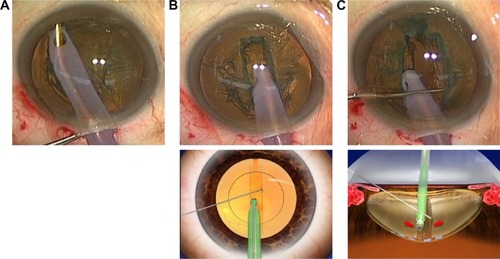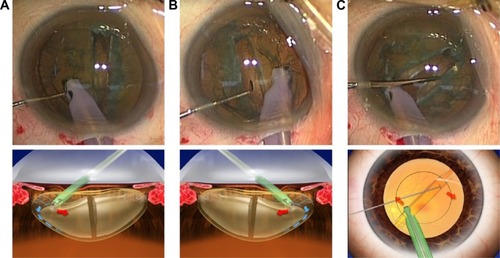Figures & data
Figure 1 Posterior iH technique.
Notes: After the phaco tip is passed under the anterior capsule within the possible range, a vertical groove is sculpted in accordance with the divide and conquer method (A). The phacoemulsification tip exerts centrifugal force from the vertical groove sculpture on the base of the left-hand wall of the trench and from the hook on the base of the right-hand wall of the trench (cross action) with vacuuming of intraocular fluid by the phaco tip. This induces the irrigation flow from the phaco tip sleeve into the posterior cortical-capsular layers (B). As a result, the vertical groove sculpture is cracked into two hemispheres, with the irrigation dynamic pressure from the tip sleeve used to cleave the posterior cortical-capsular layer. The procedure is then repeated at several points on the vertical groove sculpture, with inversion of the phaco tip and the hook position (non-cross action) making it possible to complete the posterior cortical-capsular cleavage. The schematic illustration shows the direction of the movement of the lens segments caused by the instruments (red arrows), the vacuuming of the aqueous (white lines), and the irrigation flow (blue arrows).
Abbreviation: iH, irrigation-hydro.
Abbreviation: iH, irrigation-hydro.

Figure 2 Anterior iH technique.
Notes: Following the placement of the phacoemulsification tip under the capsulorhexis edge, the aqueous humor is vacuumed and/or the side-port is depressed to induce irrigation flow into the anterior cortical-capsular layer (A). Subsequently the irrigation dynamic pressure is used to cleave the anterior, equatorial cortical-capsular layers (B). The schematic illustration shows the direction of the movement of the lens segments caused by the instruments (red arrows), the vacuuming of the aqueous (white lines), and the irrigation flow (blue arrows).
Abbreviation: iH, irrigation-hydro.
Abbreviation: iH, irrigation-hydro.

Figure 3 Posterior iH after sculpting of the vertical groove.
Notes: (A) The phaco tip is passed under the anterior capsule within the possible range. (B upper and lower) Conventional vertical groove sculpture. (C upper and lower) Posterior iH is performed sequentially at both ends and at the center of the vertical groove sculpture. As a result, this leads to the separation of the posterior cortical-capsular connection. If the anterior cortical-capsular connection can also be separated by using this procedure, the anterior iH technique does not need to be performed, and the lens can be freed from the cortical-capsular connection by using the phacoemulsification tip to circumferentially rotate it for removal by a hook. The schematic illustration shows the direction of the movement of the lens segments caused by the instruments (red arrows), the vacuuming of the aqueous (white lines), and the irrigation flow (blue arrows).
Abbreviation: iH, irrigation-hydro.
Abbreviation: iH, irrigation-hydro.

Figure 4 Anterior iH after posterior cleavage, if needed.
Notes: (A upper and lower) The phacoemulsification tip is placed under the left capsulorhexis edge, with anterior cortical-capsular iH then performed on the left hemi-nucleus in order to free the cortical-capsular connection. (B upper and lower) Anterior cortical-capsular iH is performed on the right hemi-nucleus, in order to free the right hemi-nucleus. (C upper and lower) Following the posterior and anterior cortical-capsular iH, the lens is freed from the cortical-capsular connection and can be rotated circumferentially by the phacoemulsification tip for removal by a hook. The schematic illustration shows the direction of the movement of the lens segments caused by the instruments (red arrows), the vacuuming of the aqueous (white lines), and the irrigation flow (blue arrows).
Abbreviation: iH, irrigation-hydro.
Abbreviation: iH, irrigation-hydro.

